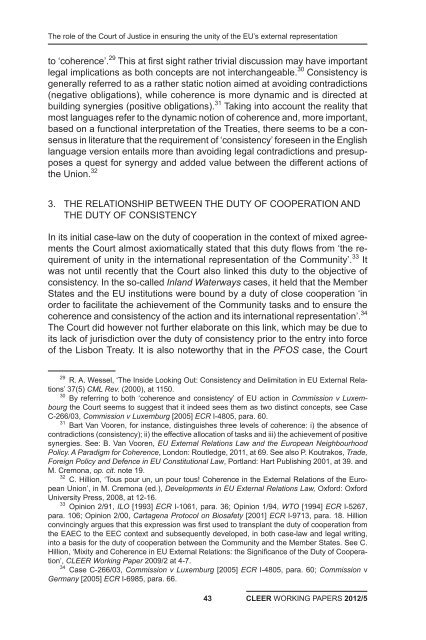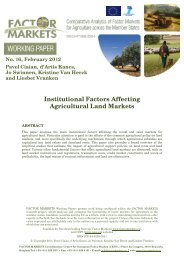Principles and practices of EU external representation - Asser Institute
Principles and practices of EU external representation - Asser Institute
Principles and practices of EU external representation - Asser Institute
You also want an ePaper? Increase the reach of your titles
YUMPU automatically turns print PDFs into web optimized ePapers that Google loves.
The role <strong>of</strong> the Court <strong>of</strong> Justice in ensuring the unity <strong>of</strong> the <strong>EU</strong>’s <strong>external</strong> <strong>representation</strong>to ‘coherence’. 29 This at first sight rather trivial discussion may have importantlegal implications as both concepts are not interchangeable. 30 Consistency isgenerally referred to as a rather static notion aimed at avoiding contradictions(negative obligations), while coherence is more dynamic <strong>and</strong> is directed atbuilding synergies (positive obligations). 31 Taking into account the reality thatmost languages refer to the dynamic notion <strong>of</strong> coherence <strong>and</strong>, more important,based on a functional interpretation <strong>of</strong> the Treaties, there seems to be a consensusin literature that the requirement <strong>of</strong> ‘consistency’ foreseen in the Englishlanguage version entails more than avoiding legal contradictions <strong>and</strong> presupposesa quest for synergy <strong>and</strong> added value between the different actions <strong>of</strong>the Union. 323. The Relationship between the Duty <strong>of</strong> Cooperation <strong>and</strong>the Duty <strong>of</strong> ConsistencyIn its initial case-law on the duty <strong>of</strong> cooperation in the context <strong>of</strong> mixed agreementsthe Court almost axiomatically stated that this duty flows from ‘the requirement<strong>of</strong> unity in the international <strong>representation</strong> <strong>of</strong> the Community’. 33 Itwas not until recently that the Court also linked this duty to the objective <strong>of</strong>consistency. In the so-called Inl<strong>and</strong> Waterways cases, it held that the MemberStates <strong>and</strong> the <strong>EU</strong> institutions were bound by a duty <strong>of</strong> close cooperation ‘inorder to facilitate the achievement <strong>of</strong> the Community tasks <strong>and</strong> to ensure thecoherence <strong>and</strong> consistency <strong>of</strong> the action <strong>and</strong> its international <strong>representation</strong>’. 34The Court did however not further elaborate on this link, which may be due toits lack <strong>of</strong> jurisdiction over the duty <strong>of</strong> consistency prior to the entry into force<strong>of</strong> the Lisbon Treaty. It is also noteworthy that in the PFOS case, the Court29 R. A. Wessel, ‘The Inside Looking Out: Consistency <strong>and</strong> Delimitation in <strong>EU</strong> External Relations’37(5) CML Rev. (2000), at 1150.30 By referring to both ‘coherence <strong>and</strong> consistency’ <strong>of</strong> <strong>EU</strong> action in Commission v Luxembourgthe Court seems to suggest that it indeed sees them as two distinct concepts, see CaseC-266/03, Commission v Luxemburg [2005] ECR I-4805, para. 60.31 Bart Van Vooren, for instance, distinguishes three levels <strong>of</strong> coherence: i) the absence <strong>of</strong>contradictions (consistency); ii) the effective allocation <strong>of</strong> tasks <strong>and</strong> iii) the achievement <strong>of</strong> positivesynergies. See: B. Van Vooren, <strong>EU</strong> External Relations Law <strong>and</strong> the European NeighbourhoodPolicy. A Paradigm for Coherence, London: Routledge, 2011, at 69. See also P. Koutrakos, Trade,Foreign Policy <strong>and</strong> Defence in <strong>EU</strong> Constitutional Law, Portl<strong>and</strong>: Hart Publishing 2001, at 39. <strong>and</strong>M. Cremona, op. cit. note 19.32 C. Hillion, ‘Tous pour un, un pour tous! Coherence in the External Relations <strong>of</strong> the EuropeanUnion’, in M. Cremona (ed.), Developments in <strong>EU</strong> External Relations Law, Oxford: OxfordUniversity Press, 2008, at 12-16.33 Opinion 2/91, ILO [1993] ECR I-1061, para. 36; Opinion 1/94, WTO [1994] ECR I-5267,para. 106; Opinion 2/00, Cartagena Protocol on Biosafety [2001] ECR I-9713, para. 18. Hillionconvincingly argues that this expression was first used to transplant the duty <strong>of</strong> cooperation fromthe EAEC to the EEC context <strong>and</strong> subsequently developed, in both case-law <strong>and</strong> legal writing,into a basis for the duty <strong>of</strong> cooperation between the Community <strong>and</strong> the Member States. See C.Hillion, ‘Mixity <strong>and</strong> Coherence in <strong>EU</strong> External Relations: the Significance <strong>of</strong> the Duty <strong>of</strong> Cooperation’,CLEER Working Paper 2009/2 at 4-7.34 Case C-266/03, Commission v Luxemburg [2005] ECR I-4805, para. 60; Commission vGermany [2005] ECR I-6985, para. 66.43CLEER WORKING PAPERS 2012/5








